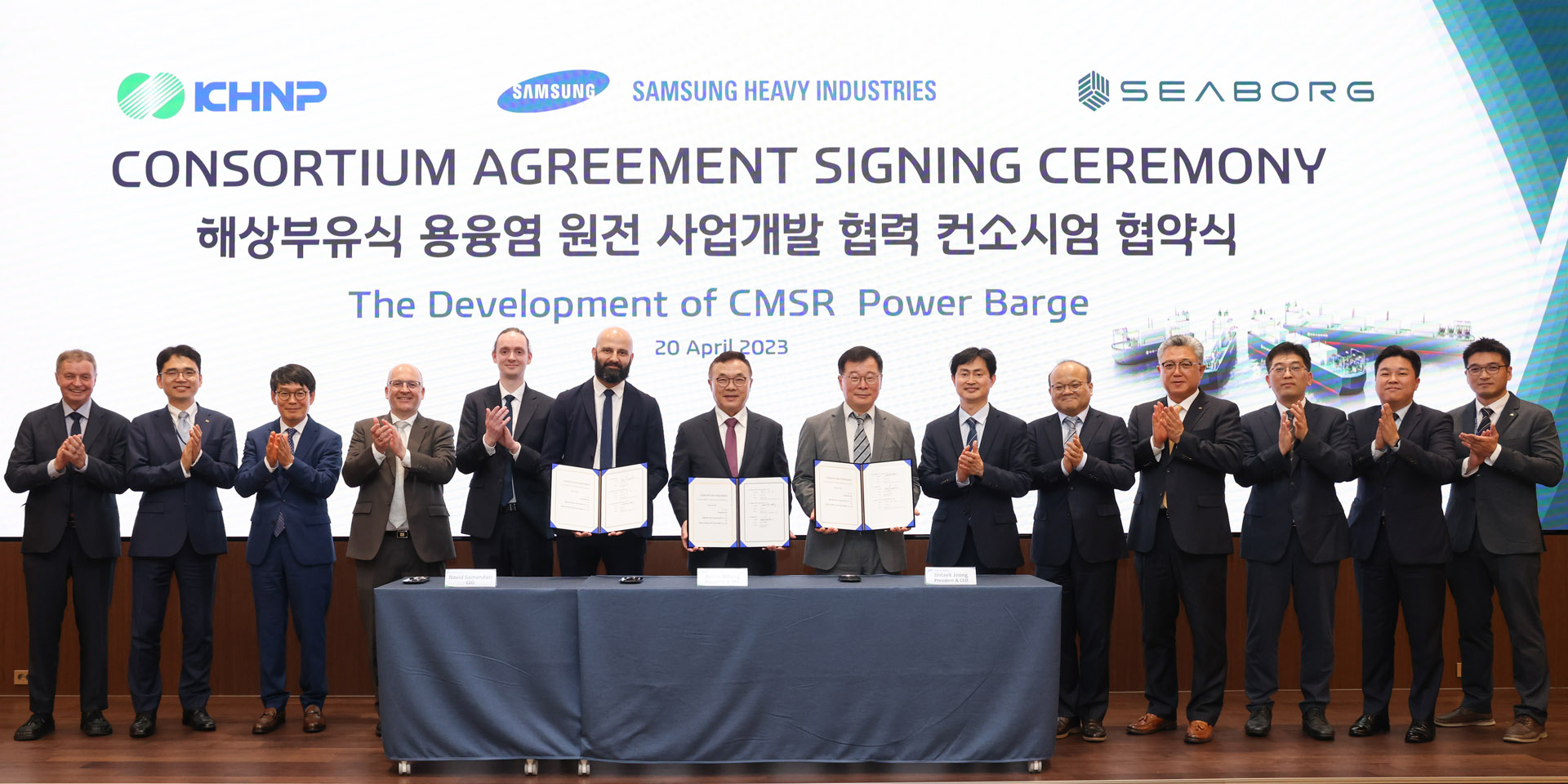A Nucor electric arc furnace. (Photo: Nucor)
NuScale Power and steel manufacturer Nucor have signed a memorandum of understanding to explore the deployment of NuScale’s VOYGR small modular reactor plants at Nucor’s scrap-based electric arc furnace (EAF) steel mills, the Portland, Ore.–based SMR developer announced Tuesday.
Officials from the U.S. and Romanian governments, NuScale, and Nuclearelectrica gather at the University Politehnica of Bucharest on May 12 to debut the first NuScale E2 Center in Europe in preparation for the deployment of a VOYGR SMR power plant in Doicești, Romania. (Photo: NuScale Power )
NuScale Power has announced the opening of its fifth Energy Exploration (E2) Center, at the University Politehnica of Bucharest, in support of the small modular reactor developer’s ongoing collaboration with the U.S. and Romanian governments and Nuclearelectrica, operator of Romania’s Cernavoda nuclear power plant.
A cutaway depiction of the AP300 SMR. (Image: Westinghouse)
Just days after immediately achieving key-player status in the small modular reactor market with the unveiling of its AP300 SMR, Westinghouse Electric Company on May 9 announced the filing of the new unit’s preapplication regulatory engagement plan with the Nuclear Regulatory Commission.
The plan outlines the preapplication activities Westinghouse intends to carry out with NRC staff to support the AP300’s licensing. According to the announcement, the plan documents the basic design philosophy of the technology, an overview of the proposed licensing approach, and a timeline for the planned preapplication interactions between the NRC and Westinghouse, with the goal of soliciting agency feedback on noteworthy topics.
A digital rendering of the Dow/X-energy Xe-100 plant in Texas. (Image: X-energy)
Dow and X-energy have announced the location of their Xe-100 small modular reactor deployment project: Dow’s UCC Seadrift Operations manufacturing site in Texas. According to a May 11 joint news release, the SMR plant will provide the Seadrift site with power and heat as the site’s existing energy and steam assets near the end of their operational lives.
April 27, 2023, 9:30AMUpdated April 27, 2023, 9:30AMNuclear News At table, from left: Navid Samandari, chief executive officer of Seaborg Technologies; Jooho Whang, CEO of KHNP; and Jintaek Jeong, CEO of Samsung Heavy Industries. (Photo: Seaborg Technologies)
Denmark-based Seaborg Technologies, developer of the compact molten salt reactor (CMSR), has teamed with two South Korean firms—shipbuilder Samsung Heavy Industries (SHI) and nuclear plant owner and operator Korea Hydro & Nuclear Power (KHNP)—to form a consortium for the development of floating nuclear plants featuring the CMSR. The consortium agreement was signed in Seoul on April 20.
Joo Han-Gyu, KAERI president, on teleconference with Albertan ministers Brian Jean and Rajan Sawhney during the signing of the MOU. (Photo: KAERI)
The Korea Atomic Energy Research Institute (KAERI) and the government of Alberta have agreed on a comprehensive cooperation framework to explore the viability of using small modular reactors to help decarbonize the province—Canada’s biggest energy producer and its biggest polluter. The announcement comes the same week that Alberta’s United Conservative Party government released a climate plan aimed at reaching net zero by 2050.
Rendering of a Rolls-Royce SMR plant. (Image: Rolls-Royce SMR)
The United Kingdom’s nuclear regulators—the Office for Nuclear Regulation (ONR), the Environment Agency, and Natural Resources Wales (NRW)—have announced the completion of step one of their generic design assessment (GDA) for Rolls-Royce SMR’s 470-MWe small modular reactor design and the start of step two, which is expected to last 16 months.
Outokumpu’s steel mill in Tornio, Finland. (Photo: Outokumpu)
Fortum—operator of Finland’s two-unit Loviisa nuclear power plant—has signed a memorandum of understanding with Finnish stainless steel producer Outokumpu to explore decarbonizing the latter’s manufacturing operations with the help of emerging nuclear technologies, the companies announced on March 23.
Dignitaries assemble after the signing of a memorandum of agreement to help Indonesia develop a nuclear energy program. Among those at the signing were Indonesia's minister for economic affairs Airlangga Hartarto, U.S. ambassador to Indonesia Sung Y. Kim, and U.S. Department of State principal deputy assistant secretary Ann Ganzer. (Photo: State Dept./Erik A. Kurniawan)
The United States and Indonesia have announced a strategic partnership to help the latter nation develop its nuclear energy program, supporting its interest in deploying small modular reactors to meet energy security and climate goals.
A technical collaboration agreement was signed by (seated from left) Jay Wileman, GEH; Jeff Lyash, TVA; Ken Hartwick, OPG; and Rafał Kasprów, SGE; and was observed by dignitaries and an audience both in-person and online. (Photo: TVA)
“I’m glad you came to our party!” said GE Hitachi Nuclear Energy (GEH) chief nuclear officer Nicole Holmes as she prepared to announce that Wilmington, N.C.–based GEH will develop a standard design for its BWRX-300 boiling water small modular reactor with not one but three power producers representing three countries: Tennessee Valley Authority (TVA), Ontario Power Generation (OPG), and Synthos Green Energy (SGE). Celebration was a theme throughout the March 23 event held in Washington, D.C., which was flush with dignitaries representing the United States, Canada, and Poland.
A rendering of the BWRX-300 small modular reactor. (Image: NRC)
GE Hitachi Nuclear Energy’s (GEH’s) BWRX-300 technology has completed phases 1 and 2 of the Canadian Nuclear Safety Commission’s vendor design review (VDR) process, the Wilmington, N.C.–based company announced yesterday.








 With the release last week of the policy paper
With the release last week of the policy paper 




